Strategic Decision-Making, Knowledge Management, & Database at SCB
VerifiedAdded on 2023/05/30
|12
|2526
|228
Report
AI Summary
This report provides an in-depth analysis of Standard Chartered Bank's decision-making processes at both operational and strategic levels, highlighting the strengths and weaknesses of their current approaches. It examines the bank's five-step decision-making process related to monetary policy and its impact on organizational performance, noting a significant increase in net profit following the implementation of these policies. The report further explores the potential benefits of introducing a knowledge management (KM) system within Standard Chartered, discussing how KM can improve customer service, reduce costs, and enhance overall efficiency. It includes a simple database design proposal tailored for the bank, illustrating how KM principles can be integrated into practical applications. The conclusion emphasizes the importance of adapting to new systems and the potential for further improvements in decision-making and organizational outcomes through the adoption of knowledge management strategies.
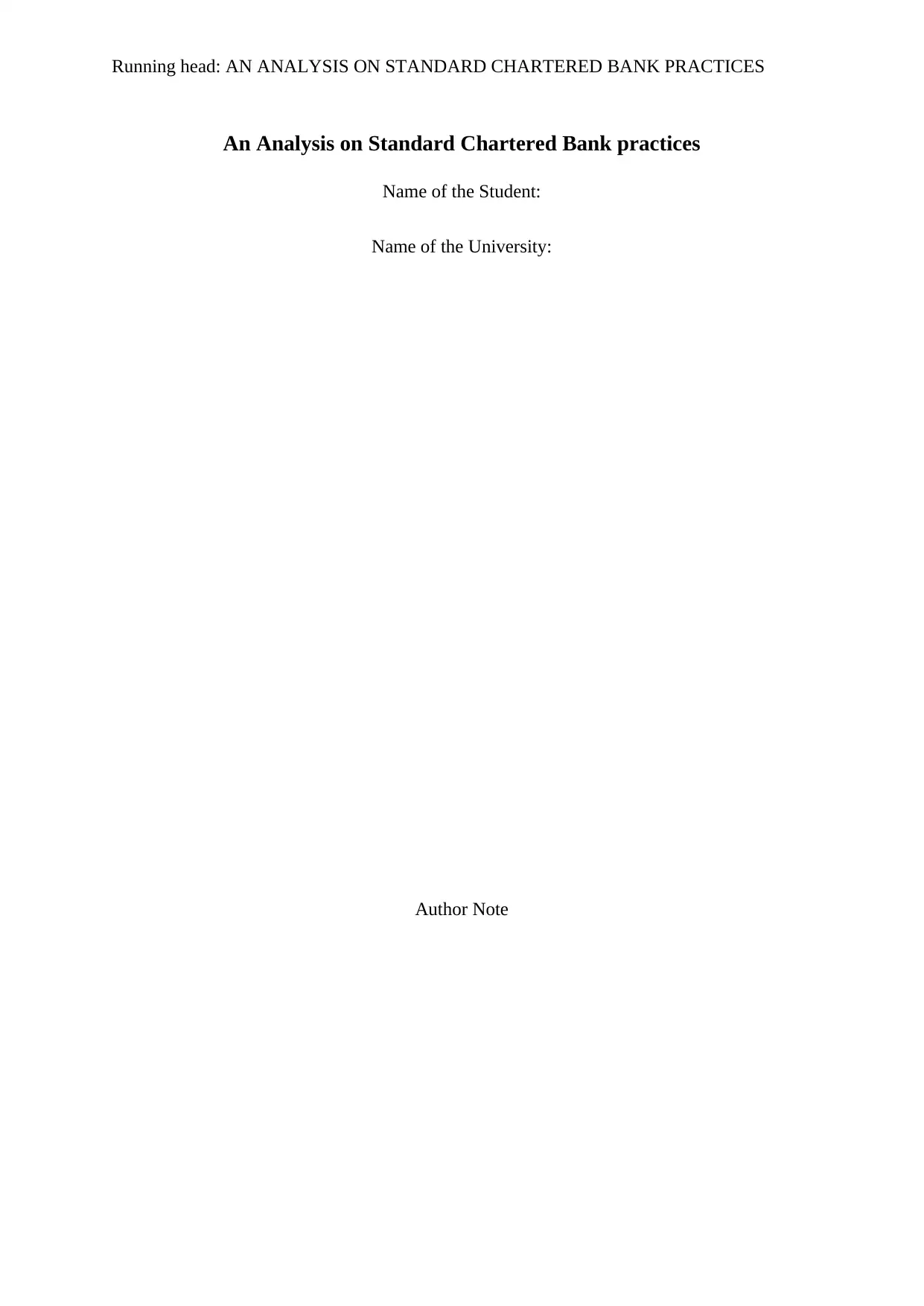
Running head: AN ANALYSIS ON STANDARD CHARTERED BANK PRACTICES
An Analysis on Standard Chartered Bank practices
Name of the Student:
Name of the University:
Author Note
An Analysis on Standard Chartered Bank practices
Name of the Student:
Name of the University:
Author Note
Paraphrase This Document
Need a fresh take? Get an instant paraphrase of this document with our AI Paraphraser
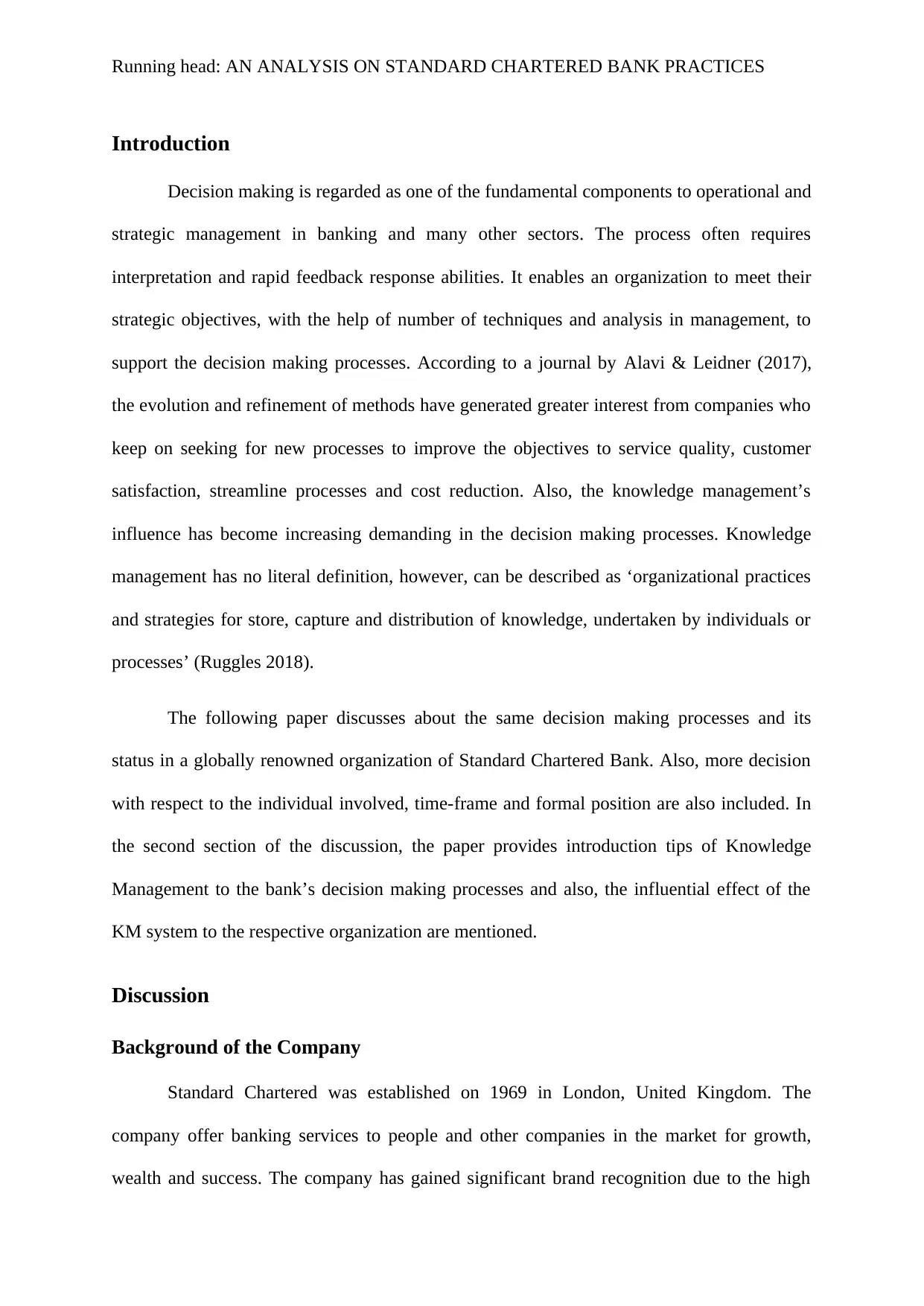
Running head: AN ANALYSIS ON STANDARD CHARTERED BANK PRACTICES
Introduction
Decision making is regarded as one of the fundamental components to operational and
strategic management in banking and many other sectors. The process often requires
interpretation and rapid feedback response abilities. It enables an organization to meet their
strategic objectives, with the help of number of techniques and analysis in management, to
support the decision making processes. According to a journal by Alavi & Leidner (2017),
the evolution and refinement of methods have generated greater interest from companies who
keep on seeking for new processes to improve the objectives to service quality, customer
satisfaction, streamline processes and cost reduction. Also, the knowledge management’s
influence has become increasing demanding in the decision making processes. Knowledge
management has no literal definition, however, can be described as ‘organizational practices
and strategies for store, capture and distribution of knowledge, undertaken by individuals or
processes’ (Ruggles 2018).
The following paper discusses about the same decision making processes and its
status in a globally renowned organization of Standard Chartered Bank. Also, more decision
with respect to the individual involved, time-frame and formal position are also included. In
the second section of the discussion, the paper provides introduction tips of Knowledge
Management to the bank’s decision making processes and also, the influential effect of the
KM system to the respective organization are mentioned.
Discussion
Background of the Company
Standard Chartered was established on 1969 in London, United Kingdom. The
company offer banking services to people and other companies in the market for growth,
wealth and success. The company has gained significant brand recognition due to the high
Introduction
Decision making is regarded as one of the fundamental components to operational and
strategic management in banking and many other sectors. The process often requires
interpretation and rapid feedback response abilities. It enables an organization to meet their
strategic objectives, with the help of number of techniques and analysis in management, to
support the decision making processes. According to a journal by Alavi & Leidner (2017),
the evolution and refinement of methods have generated greater interest from companies who
keep on seeking for new processes to improve the objectives to service quality, customer
satisfaction, streamline processes and cost reduction. Also, the knowledge management’s
influence has become increasing demanding in the decision making processes. Knowledge
management has no literal definition, however, can be described as ‘organizational practices
and strategies for store, capture and distribution of knowledge, undertaken by individuals or
processes’ (Ruggles 2018).
The following paper discusses about the same decision making processes and its
status in a globally renowned organization of Standard Chartered Bank. Also, more decision
with respect to the individual involved, time-frame and formal position are also included. In
the second section of the discussion, the paper provides introduction tips of Knowledge
Management to the bank’s decision making processes and also, the influential effect of the
KM system to the respective organization are mentioned.
Discussion
Background of the Company
Standard Chartered was established on 1969 in London, United Kingdom. The
company offer banking services to people and other companies in the market for growth,
wealth and success. The company has gained significant brand recognition due to the high
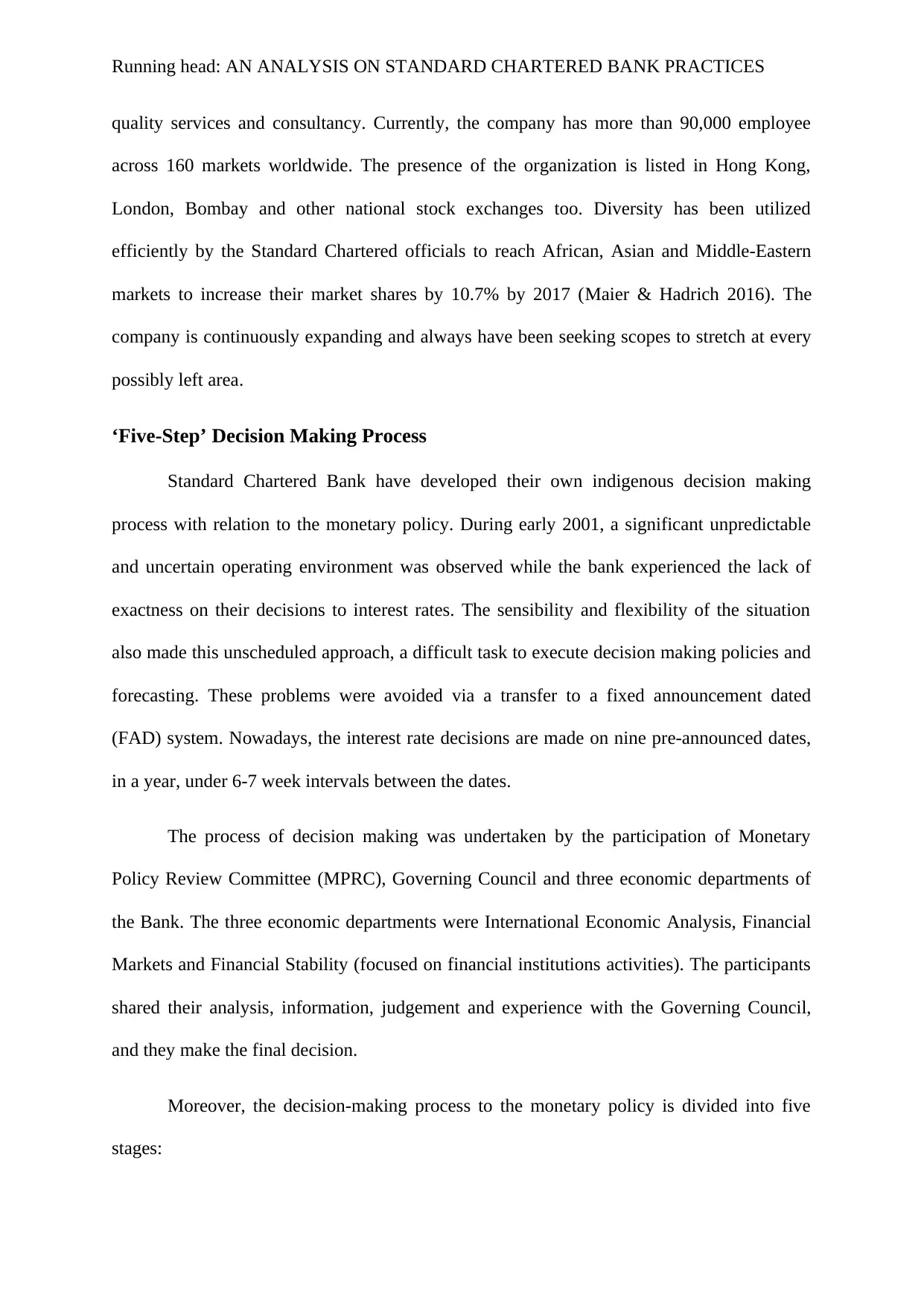
Running head: AN ANALYSIS ON STANDARD CHARTERED BANK PRACTICES
quality services and consultancy. Currently, the company has more than 90,000 employee
across 160 markets worldwide. The presence of the organization is listed in Hong Kong,
London, Bombay and other national stock exchanges too. Diversity has been utilized
efficiently by the Standard Chartered officials to reach African, Asian and Middle-Eastern
markets to increase their market shares by 10.7% by 2017 (Maier & Hadrich 2016). The
company is continuously expanding and always have been seeking scopes to stretch at every
possibly left area.
‘Five-Step’ Decision Making Process
Standard Chartered Bank have developed their own indigenous decision making
process with relation to the monetary policy. During early 2001, a significant unpredictable
and uncertain operating environment was observed while the bank experienced the lack of
exactness on their decisions to interest rates. The sensibility and flexibility of the situation
also made this unscheduled approach, a difficult task to execute decision making policies and
forecasting. These problems were avoided via a transfer to a fixed announcement dated
(FAD) system. Nowadays, the interest rate decisions are made on nine pre-announced dates,
in a year, under 6-7 week intervals between the dates.
The process of decision making was undertaken by the participation of Monetary
Policy Review Committee (MPRC), Governing Council and three economic departments of
the Bank. The three economic departments were International Economic Analysis, Financial
Markets and Financial Stability (focused on financial institutions activities). The participants
shared their analysis, information, judgement and experience with the Governing Council,
and they make the final decision.
Moreover, the decision-making process to the monetary policy is divided into five
stages:
quality services and consultancy. Currently, the company has more than 90,000 employee
across 160 markets worldwide. The presence of the organization is listed in Hong Kong,
London, Bombay and other national stock exchanges too. Diversity has been utilized
efficiently by the Standard Chartered officials to reach African, Asian and Middle-Eastern
markets to increase their market shares by 10.7% by 2017 (Maier & Hadrich 2016). The
company is continuously expanding and always have been seeking scopes to stretch at every
possibly left area.
‘Five-Step’ Decision Making Process
Standard Chartered Bank have developed their own indigenous decision making
process with relation to the monetary policy. During early 2001, a significant unpredictable
and uncertain operating environment was observed while the bank experienced the lack of
exactness on their decisions to interest rates. The sensibility and flexibility of the situation
also made this unscheduled approach, a difficult task to execute decision making policies and
forecasting. These problems were avoided via a transfer to a fixed announcement dated
(FAD) system. Nowadays, the interest rate decisions are made on nine pre-announced dates,
in a year, under 6-7 week intervals between the dates.
The process of decision making was undertaken by the participation of Monetary
Policy Review Committee (MPRC), Governing Council and three economic departments of
the Bank. The three economic departments were International Economic Analysis, Financial
Markets and Financial Stability (focused on financial institutions activities). The participants
shared their analysis, information, judgement and experience with the Governing Council,
and they make the final decision.
Moreover, the decision-making process to the monetary policy is divided into five
stages:
⊘ This is a preview!⊘
Do you want full access?
Subscribe today to unlock all pages.

Trusted by 1+ million students worldwide
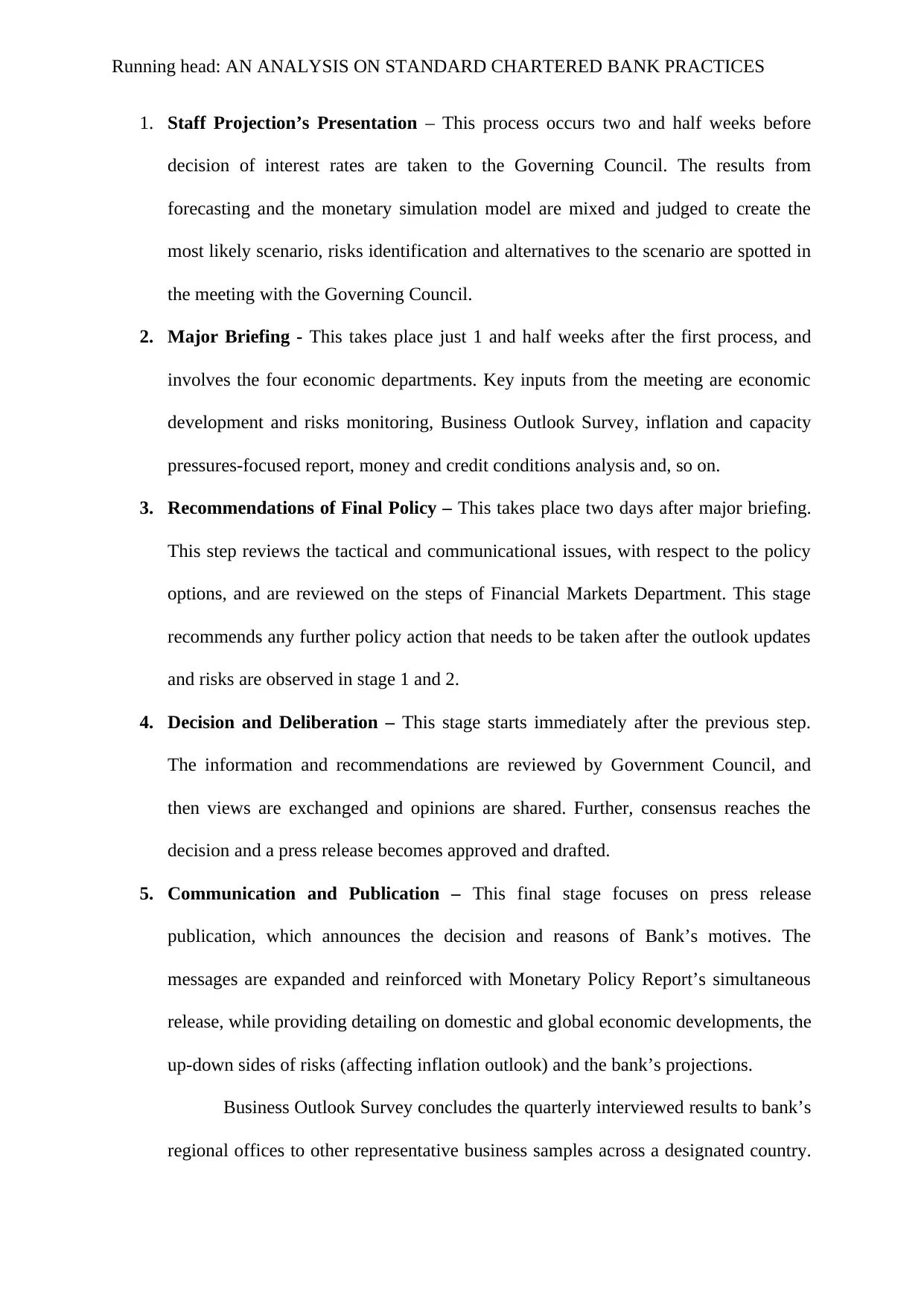
Running head: AN ANALYSIS ON STANDARD CHARTERED BANK PRACTICES
1. Staff Projection’s Presentation – This process occurs two and half weeks before
decision of interest rates are taken to the Governing Council. The results from
forecasting and the monetary simulation model are mixed and judged to create the
most likely scenario, risks identification and alternatives to the scenario are spotted in
the meeting with the Governing Council.
2. Major Briefing - This takes place just 1 and half weeks after the first process, and
involves the four economic departments. Key inputs from the meeting are economic
development and risks monitoring, Business Outlook Survey, inflation and capacity
pressures-focused report, money and credit conditions analysis and, so on.
3. Recommendations of Final Policy – This takes place two days after major briefing.
This step reviews the tactical and communicational issues, with respect to the policy
options, and are reviewed on the steps of Financial Markets Department. This stage
recommends any further policy action that needs to be taken after the outlook updates
and risks are observed in stage 1 and 2.
4. Decision and Deliberation – This stage starts immediately after the previous step.
The information and recommendations are reviewed by Government Council, and
then views are exchanged and opinions are shared. Further, consensus reaches the
decision and a press release becomes approved and drafted.
5. Communication and Publication – This final stage focuses on press release
publication, which announces the decision and reasons of Bank’s motives. The
messages are expanded and reinforced with Monetary Policy Report’s simultaneous
release, while providing detailing on domestic and global economic developments, the
up-down sides of risks (affecting inflation outlook) and the bank’s projections.
Business Outlook Survey concludes the quarterly interviewed results to bank’s
regional offices to other representative business samples across a designated country.
1. Staff Projection’s Presentation – This process occurs two and half weeks before
decision of interest rates are taken to the Governing Council. The results from
forecasting and the monetary simulation model are mixed and judged to create the
most likely scenario, risks identification and alternatives to the scenario are spotted in
the meeting with the Governing Council.
2. Major Briefing - This takes place just 1 and half weeks after the first process, and
involves the four economic departments. Key inputs from the meeting are economic
development and risks monitoring, Business Outlook Survey, inflation and capacity
pressures-focused report, money and credit conditions analysis and, so on.
3. Recommendations of Final Policy – This takes place two days after major briefing.
This step reviews the tactical and communicational issues, with respect to the policy
options, and are reviewed on the steps of Financial Markets Department. This stage
recommends any further policy action that needs to be taken after the outlook updates
and risks are observed in stage 1 and 2.
4. Decision and Deliberation – This stage starts immediately after the previous step.
The information and recommendations are reviewed by Government Council, and
then views are exchanged and opinions are shared. Further, consensus reaches the
decision and a press release becomes approved and drafted.
5. Communication and Publication – This final stage focuses on press release
publication, which announces the decision and reasons of Bank’s motives. The
messages are expanded and reinforced with Monetary Policy Report’s simultaneous
release, while providing detailing on domestic and global economic developments, the
up-down sides of risks (affecting inflation outlook) and the bank’s projections.
Business Outlook Survey concludes the quarterly interviewed results to bank’s
regional offices to other representative business samples across a designated country.
Paraphrase This Document
Need a fresh take? Get an instant paraphrase of this document with our AI Paraphraser
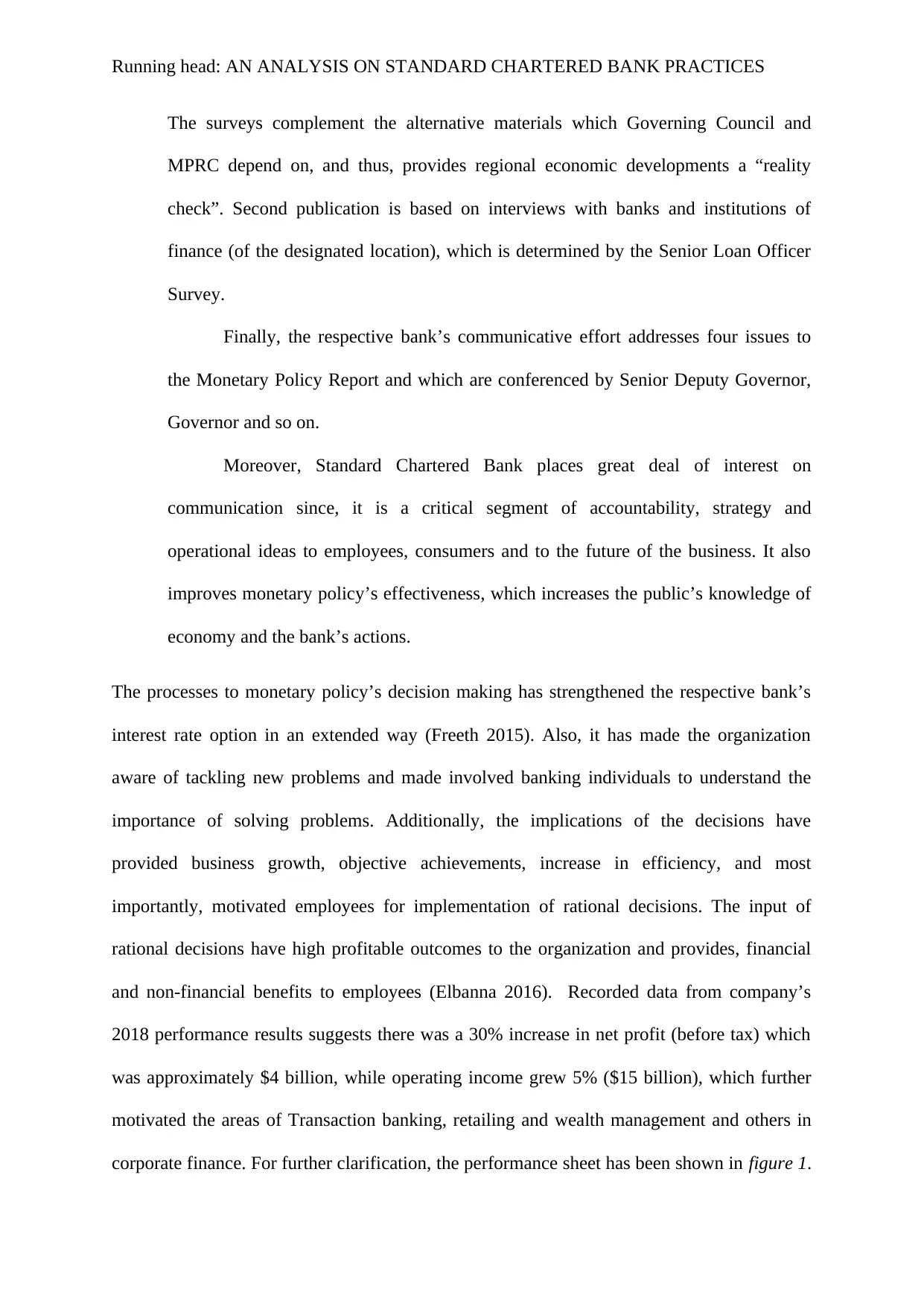
Running head: AN ANALYSIS ON STANDARD CHARTERED BANK PRACTICES
The surveys complement the alternative materials which Governing Council and
MPRC depend on, and thus, provides regional economic developments a “reality
check”. Second publication is based on interviews with banks and institutions of
finance (of the designated location), which is determined by the Senior Loan Officer
Survey.
Finally, the respective bank’s communicative effort addresses four issues to
the Monetary Policy Report and which are conferenced by Senior Deputy Governor,
Governor and so on.
Moreover, Standard Chartered Bank places great deal of interest on
communication since, it is a critical segment of accountability, strategy and
operational ideas to employees, consumers and to the future of the business. It also
improves monetary policy’s effectiveness, which increases the public’s knowledge of
economy and the bank’s actions.
The processes to monetary policy’s decision making has strengthened the respective bank’s
interest rate option in an extended way (Freeth 2015). Also, it has made the organization
aware of tackling new problems and made involved banking individuals to understand the
importance of solving problems. Additionally, the implications of the decisions have
provided business growth, objective achievements, increase in efficiency, and most
importantly, motivated employees for implementation of rational decisions. The input of
rational decisions have high profitable outcomes to the organization and provides, financial
and non-financial benefits to employees (Elbanna 2016). Recorded data from company’s
2018 performance results suggests there was a 30% increase in net profit (before tax) which
was approximately $4 billion, while operating income grew 5% ($15 billion), which further
motivated the areas of Transaction banking, retailing and wealth management and others in
corporate finance. For further clarification, the performance sheet has been shown in figure 1.
The surveys complement the alternative materials which Governing Council and
MPRC depend on, and thus, provides regional economic developments a “reality
check”. Second publication is based on interviews with banks and institutions of
finance (of the designated location), which is determined by the Senior Loan Officer
Survey.
Finally, the respective bank’s communicative effort addresses four issues to
the Monetary Policy Report and which are conferenced by Senior Deputy Governor,
Governor and so on.
Moreover, Standard Chartered Bank places great deal of interest on
communication since, it is a critical segment of accountability, strategy and
operational ideas to employees, consumers and to the future of the business. It also
improves monetary policy’s effectiveness, which increases the public’s knowledge of
economy and the bank’s actions.
The processes to monetary policy’s decision making has strengthened the respective bank’s
interest rate option in an extended way (Freeth 2015). Also, it has made the organization
aware of tackling new problems and made involved banking individuals to understand the
importance of solving problems. Additionally, the implications of the decisions have
provided business growth, objective achievements, increase in efficiency, and most
importantly, motivated employees for implementation of rational decisions. The input of
rational decisions have high profitable outcomes to the organization and provides, financial
and non-financial benefits to employees (Elbanna 2016). Recorded data from company’s
2018 performance results suggests there was a 30% increase in net profit (before tax) which
was approximately $4 billion, while operating income grew 5% ($15 billion), which further
motivated the areas of Transaction banking, retailing and wealth management and others in
corporate finance. For further clarification, the performance sheet has been shown in figure 1.
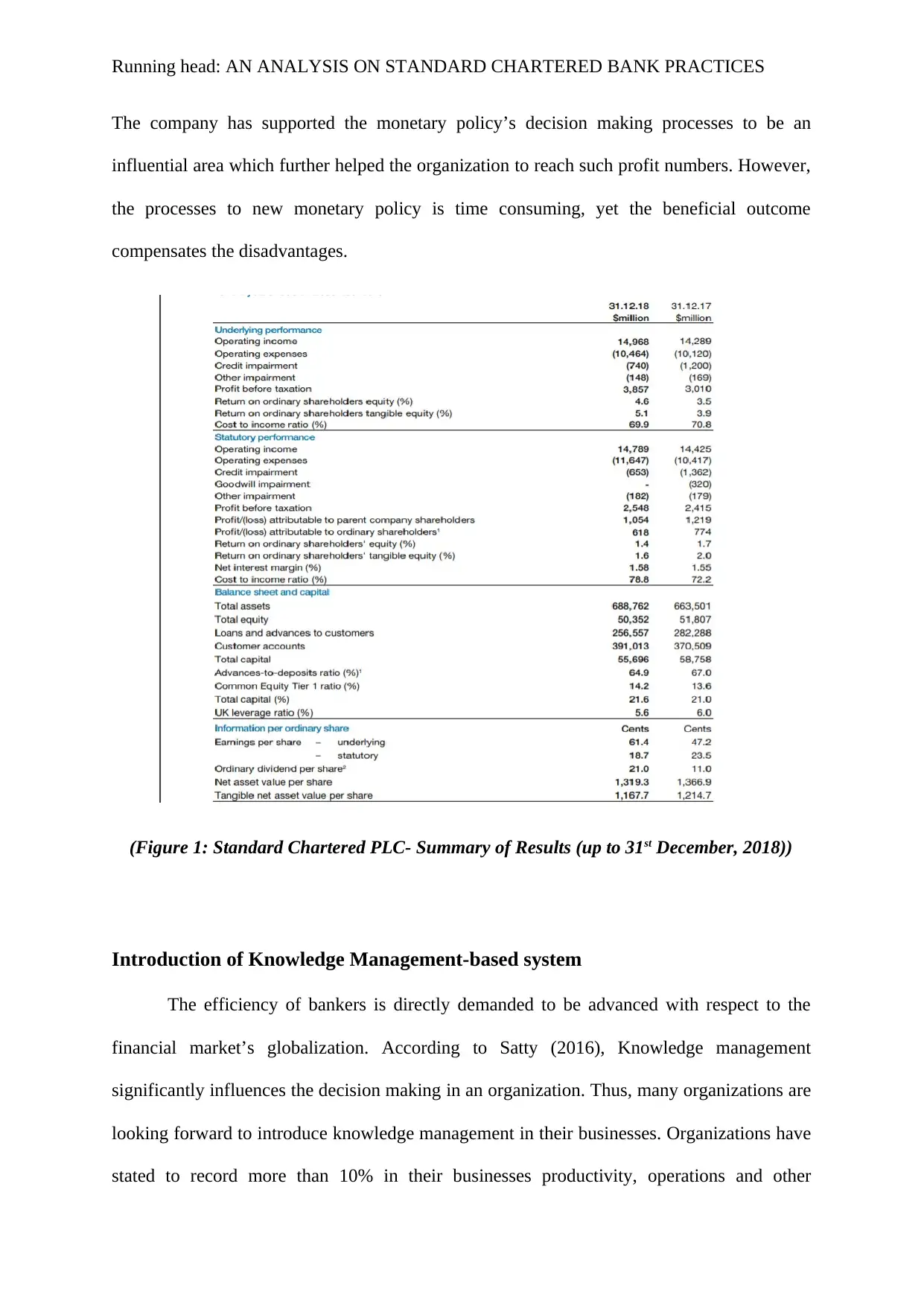
Running head: AN ANALYSIS ON STANDARD CHARTERED BANK PRACTICES
The company has supported the monetary policy’s decision making processes to be an
influential area which further helped the organization to reach such profit numbers. However,
the processes to new monetary policy is time consuming, yet the beneficial outcome
compensates the disadvantages.
(Figure 1: Standard Chartered PLC- Summary of Results (up to 31st December, 2018))
Introduction of Knowledge Management-based system
The efficiency of bankers is directly demanded to be advanced with respect to the
financial market’s globalization. According to Satty (2016), Knowledge management
significantly influences the decision making in an organization. Thus, many organizations are
looking forward to introduce knowledge management in their businesses. Organizations have
stated to record more than 10% in their businesses productivity, operations and other
The company has supported the monetary policy’s decision making processes to be an
influential area which further helped the organization to reach such profit numbers. However,
the processes to new monetary policy is time consuming, yet the beneficial outcome
compensates the disadvantages.
(Figure 1: Standard Chartered PLC- Summary of Results (up to 31st December, 2018))
Introduction of Knowledge Management-based system
The efficiency of bankers is directly demanded to be advanced with respect to the
financial market’s globalization. According to Satty (2016), Knowledge management
significantly influences the decision making in an organization. Thus, many organizations are
looking forward to introduce knowledge management in their businesses. Organizations have
stated to record more than 10% in their businesses productivity, operations and other
⊘ This is a preview!⊘
Do you want full access?
Subscribe today to unlock all pages.

Trusted by 1+ million students worldwide
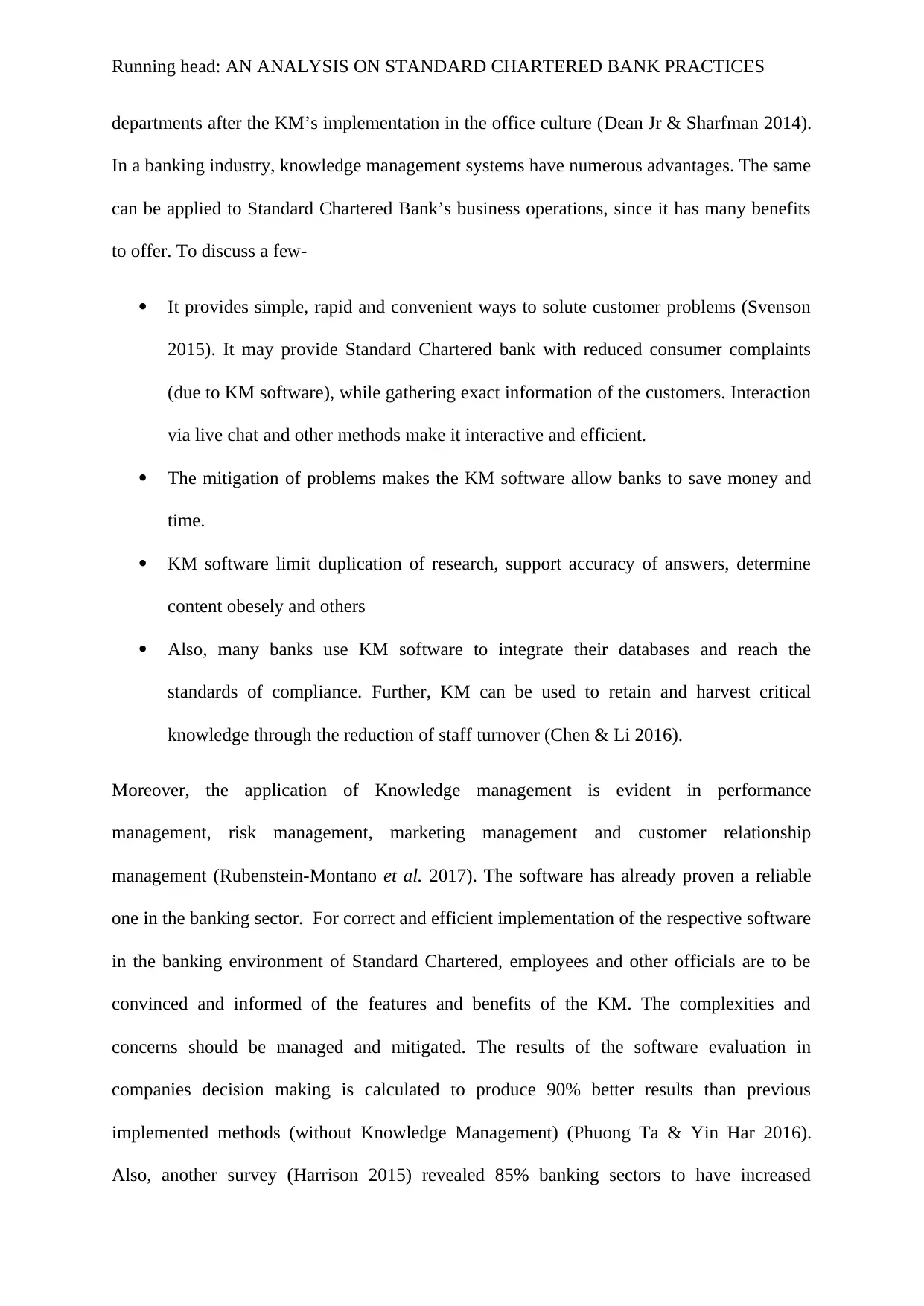
Running head: AN ANALYSIS ON STANDARD CHARTERED BANK PRACTICES
departments after the KM’s implementation in the office culture (Dean Jr & Sharfman 2014).
In a banking industry, knowledge management systems have numerous advantages. The same
can be applied to Standard Chartered Bank’s business operations, since it has many benefits
to offer. To discuss a few-
It provides simple, rapid and convenient ways to solute customer problems (Svenson
2015). It may provide Standard Chartered bank with reduced consumer complaints
(due to KM software), while gathering exact information of the customers. Interaction
via live chat and other methods make it interactive and efficient.
The mitigation of problems makes the KM software allow banks to save money and
time.
KM software limit duplication of research, support accuracy of answers, determine
content obesely and others
Also, many banks use KM software to integrate their databases and reach the
standards of compliance. Further, KM can be used to retain and harvest critical
knowledge through the reduction of staff turnover (Chen & Li 2016).
Moreover, the application of Knowledge management is evident in performance
management, risk management, marketing management and customer relationship
management (Rubenstein-Montano et al. 2017). The software has already proven a reliable
one in the banking sector. For correct and efficient implementation of the respective software
in the banking environment of Standard Chartered, employees and other officials are to be
convinced and informed of the features and benefits of the KM. The complexities and
concerns should be managed and mitigated. The results of the software evaluation in
companies decision making is calculated to produce 90% better results than previous
implemented methods (without Knowledge Management) (Phuong Ta & Yin Har 2016).
Also, another survey (Harrison 2015) revealed 85% banking sectors to have increased
departments after the KM’s implementation in the office culture (Dean Jr & Sharfman 2014).
In a banking industry, knowledge management systems have numerous advantages. The same
can be applied to Standard Chartered Bank’s business operations, since it has many benefits
to offer. To discuss a few-
It provides simple, rapid and convenient ways to solute customer problems (Svenson
2015). It may provide Standard Chartered bank with reduced consumer complaints
(due to KM software), while gathering exact information of the customers. Interaction
via live chat and other methods make it interactive and efficient.
The mitigation of problems makes the KM software allow banks to save money and
time.
KM software limit duplication of research, support accuracy of answers, determine
content obesely and others
Also, many banks use KM software to integrate their databases and reach the
standards of compliance. Further, KM can be used to retain and harvest critical
knowledge through the reduction of staff turnover (Chen & Li 2016).
Moreover, the application of Knowledge management is evident in performance
management, risk management, marketing management and customer relationship
management (Rubenstein-Montano et al. 2017). The software has already proven a reliable
one in the banking sector. For correct and efficient implementation of the respective software
in the banking environment of Standard Chartered, employees and other officials are to be
convinced and informed of the features and benefits of the KM. The complexities and
concerns should be managed and mitigated. The results of the software evaluation in
companies decision making is calculated to produce 90% better results than previous
implemented methods (without Knowledge Management) (Phuong Ta & Yin Har 2016).
Also, another survey (Harrison 2015) revealed 85% banking sectors to have increased
Paraphrase This Document
Need a fresh take? Get an instant paraphrase of this document with our AI Paraphraser
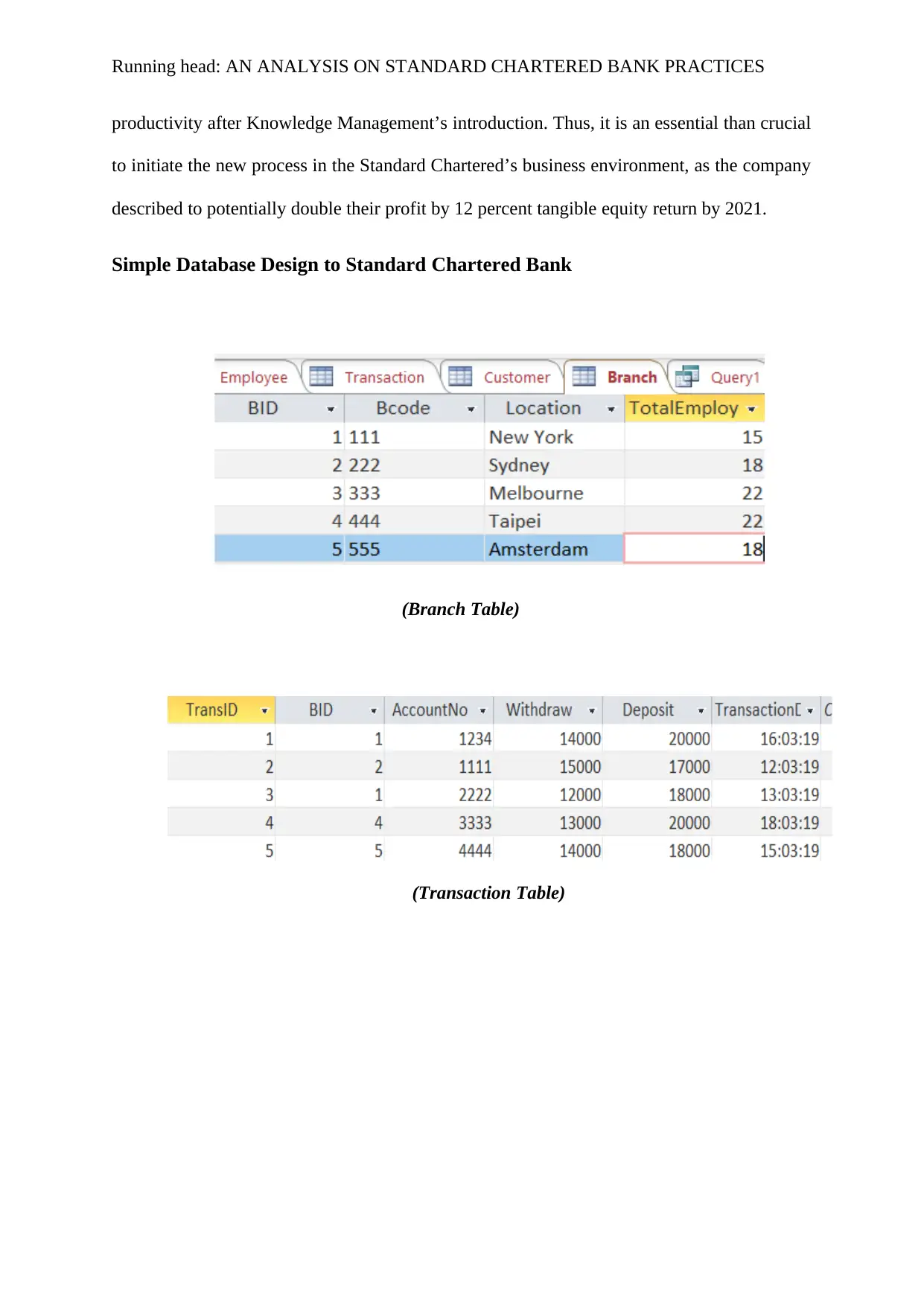
Running head: AN ANALYSIS ON STANDARD CHARTERED BANK PRACTICES
productivity after Knowledge Management’s introduction. Thus, it is an essential than crucial
to initiate the new process in the Standard Chartered’s business environment, as the company
described to potentially double their profit by 12 percent tangible equity return by 2021.
Simple Database Design to Standard Chartered Bank
(Branch Table)
(Transaction Table)
productivity after Knowledge Management’s introduction. Thus, it is an essential than crucial
to initiate the new process in the Standard Chartered’s business environment, as the company
described to potentially double their profit by 12 percent tangible equity return by 2021.
Simple Database Design to Standard Chartered Bank
(Branch Table)
(Transaction Table)
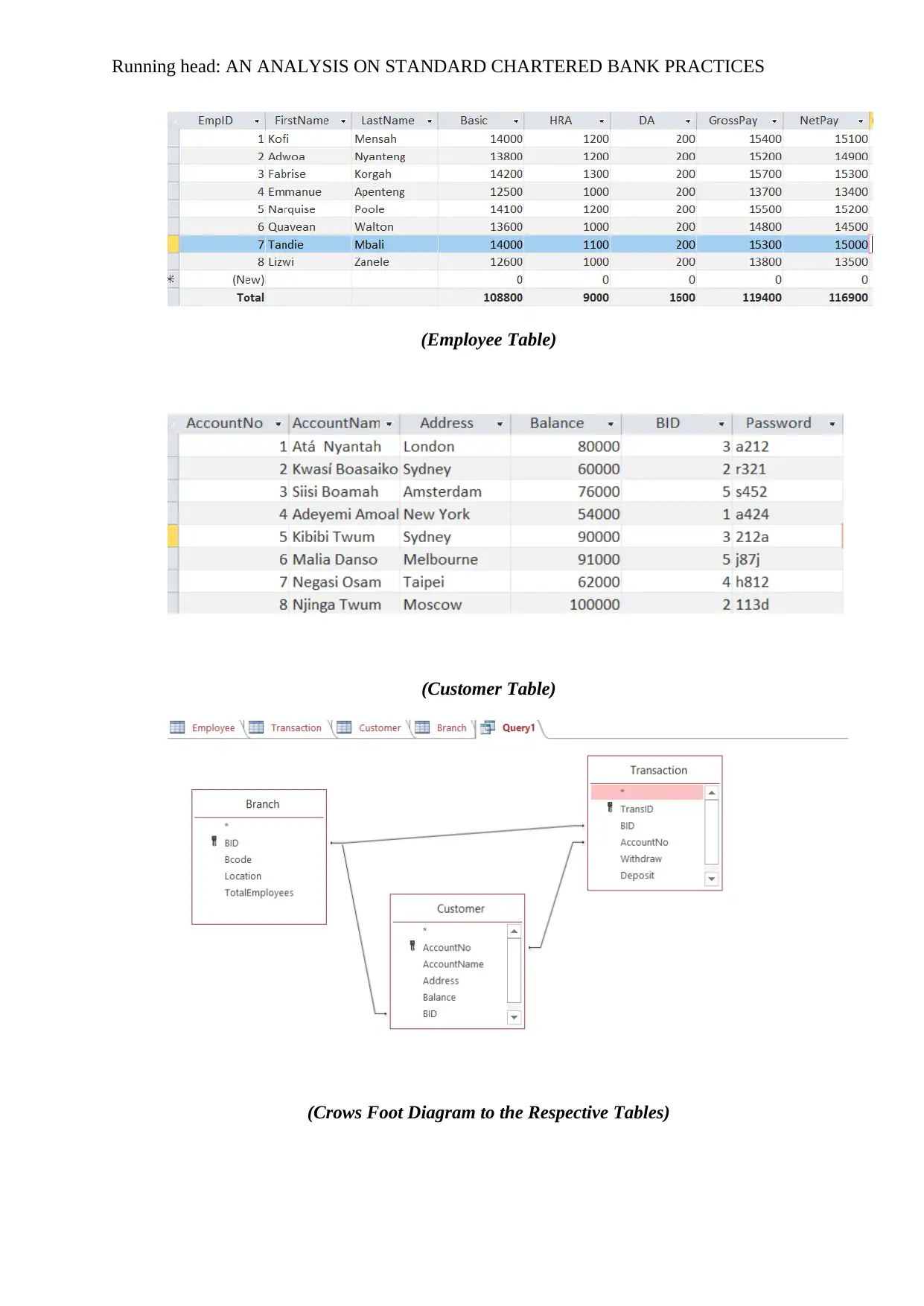
Running head: AN ANALYSIS ON STANDARD CHARTERED BANK PRACTICES
(Employee Table)
(Customer Table)
(Crows Foot Diagram to the Respective Tables)
(Employee Table)
(Customer Table)
(Crows Foot Diagram to the Respective Tables)
⊘ This is a preview!⊘
Do you want full access?
Subscribe today to unlock all pages.

Trusted by 1+ million students worldwide
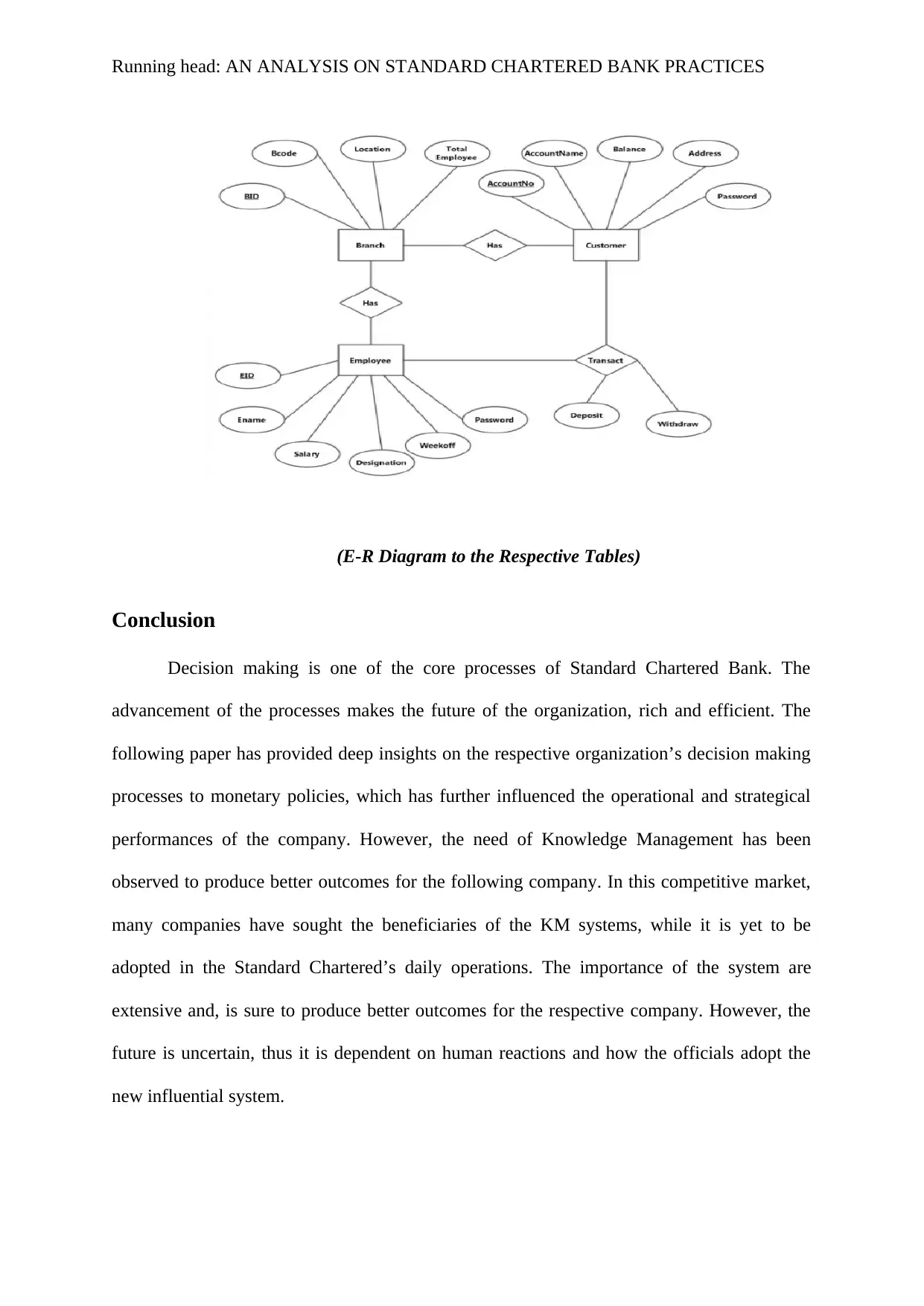
Running head: AN ANALYSIS ON STANDARD CHARTERED BANK PRACTICES
(E-R Diagram to the Respective Tables)
Conclusion
Decision making is one of the core processes of Standard Chartered Bank. The
advancement of the processes makes the future of the organization, rich and efficient. The
following paper has provided deep insights on the respective organization’s decision making
processes to monetary policies, which has further influenced the operational and strategical
performances of the company. However, the need of Knowledge Management has been
observed to produce better outcomes for the following company. In this competitive market,
many companies have sought the beneficiaries of the KM systems, while it is yet to be
adopted in the Standard Chartered’s daily operations. The importance of the system are
extensive and, is sure to produce better outcomes for the respective company. However, the
future is uncertain, thus it is dependent on human reactions and how the officials adopt the
new influential system.
(E-R Diagram to the Respective Tables)
Conclusion
Decision making is one of the core processes of Standard Chartered Bank. The
advancement of the processes makes the future of the organization, rich and efficient. The
following paper has provided deep insights on the respective organization’s decision making
processes to monetary policies, which has further influenced the operational and strategical
performances of the company. However, the need of Knowledge Management has been
observed to produce better outcomes for the following company. In this competitive market,
many companies have sought the beneficiaries of the KM systems, while it is yet to be
adopted in the Standard Chartered’s daily operations. The importance of the system are
extensive and, is sure to produce better outcomes for the respective company. However, the
future is uncertain, thus it is dependent on human reactions and how the officials adopt the
new influential system.
Paraphrase This Document
Need a fresh take? Get an instant paraphrase of this document with our AI Paraphraser
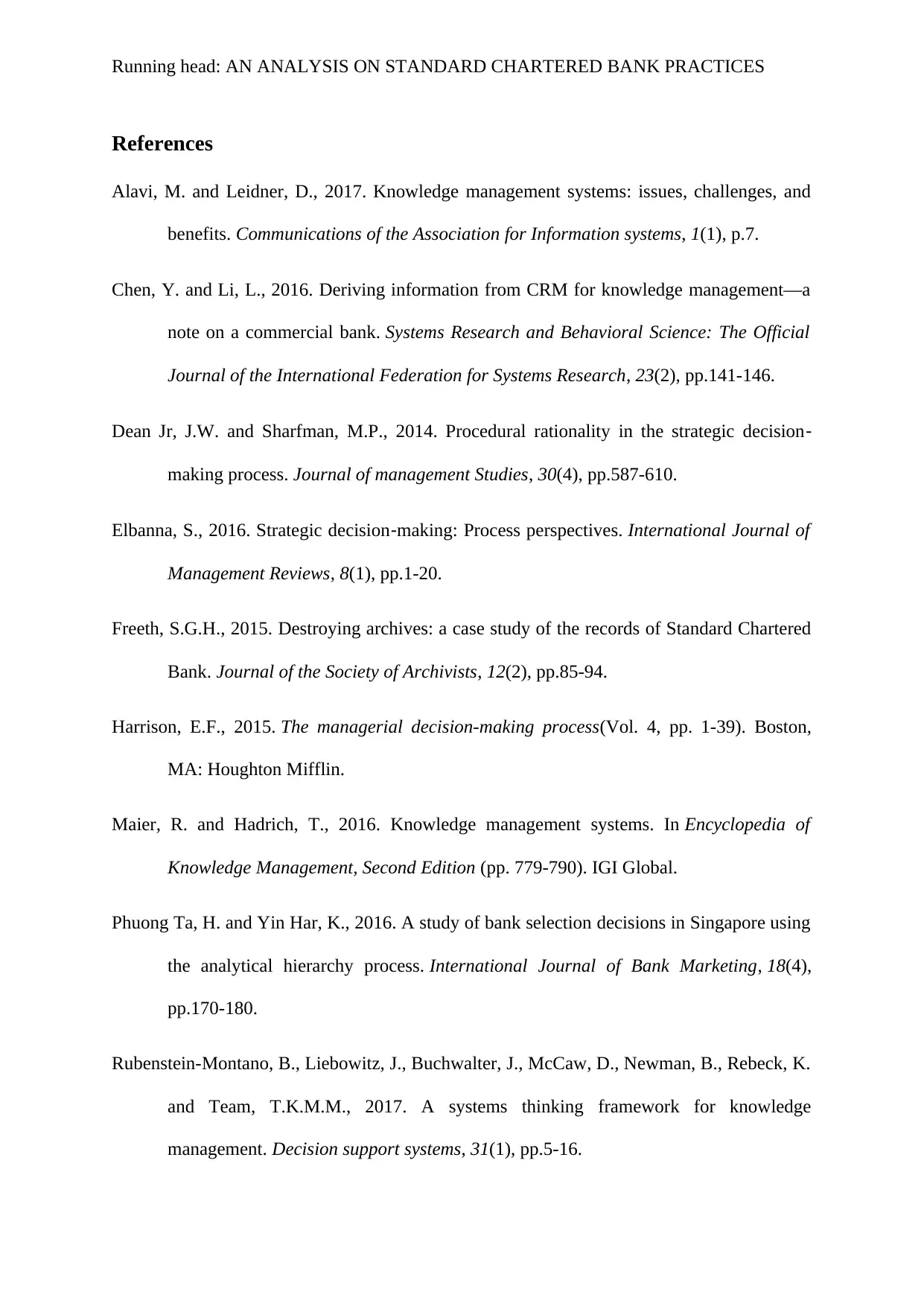
Running head: AN ANALYSIS ON STANDARD CHARTERED BANK PRACTICES
References
Alavi, M. and Leidner, D., 2017. Knowledge management systems: issues, challenges, and
benefits. Communications of the Association for Information systems, 1(1), p.7.
Chen, Y. and Li, L., 2016. Deriving information from CRM for knowledge management—a
note on a commercial bank. Systems Research and Behavioral Science: The Official
Journal of the International Federation for Systems Research, 23(2), pp.141-146.
Dean Jr, J.W. and Sharfman, M.P., 2014. Procedural rationality in the strategic decision‐
making process. Journal of management Studies, 30(4), pp.587-610.
Elbanna, S., 2016. Strategic decision‐making: Process perspectives. International Journal of
Management Reviews, 8(1), pp.1-20.
Freeth, S.G.H., 2015. Destroying archives: a case study of the records of Standard Chartered
Bank. Journal of the Society of Archivists, 12(2), pp.85-94.
Harrison, E.F., 2015. The managerial decision-making process(Vol. 4, pp. 1-39). Boston,
MA: Houghton Mifflin.
Maier, R. and Hadrich, T., 2016. Knowledge management systems. In Encyclopedia of
Knowledge Management, Second Edition (pp. 779-790). IGI Global.
Phuong Ta, H. and Yin Har, K., 2016. A study of bank selection decisions in Singapore using
the analytical hierarchy process. International Journal of Bank Marketing, 18(4),
pp.170-180.
Rubenstein-Montano, B., Liebowitz, J., Buchwalter, J., McCaw, D., Newman, B., Rebeck, K.
and Team, T.K.M.M., 2017. A systems thinking framework for knowledge
management. Decision support systems, 31(1), pp.5-16.
References
Alavi, M. and Leidner, D., 2017. Knowledge management systems: issues, challenges, and
benefits. Communications of the Association for Information systems, 1(1), p.7.
Chen, Y. and Li, L., 2016. Deriving information from CRM for knowledge management—a
note on a commercial bank. Systems Research and Behavioral Science: The Official
Journal of the International Federation for Systems Research, 23(2), pp.141-146.
Dean Jr, J.W. and Sharfman, M.P., 2014. Procedural rationality in the strategic decision‐
making process. Journal of management Studies, 30(4), pp.587-610.
Elbanna, S., 2016. Strategic decision‐making: Process perspectives. International Journal of
Management Reviews, 8(1), pp.1-20.
Freeth, S.G.H., 2015. Destroying archives: a case study of the records of Standard Chartered
Bank. Journal of the Society of Archivists, 12(2), pp.85-94.
Harrison, E.F., 2015. The managerial decision-making process(Vol. 4, pp. 1-39). Boston,
MA: Houghton Mifflin.
Maier, R. and Hadrich, T., 2016. Knowledge management systems. In Encyclopedia of
Knowledge Management, Second Edition (pp. 779-790). IGI Global.
Phuong Ta, H. and Yin Har, K., 2016. A study of bank selection decisions in Singapore using
the analytical hierarchy process. International Journal of Bank Marketing, 18(4),
pp.170-180.
Rubenstein-Montano, B., Liebowitz, J., Buchwalter, J., McCaw, D., Newman, B., Rebeck, K.
and Team, T.K.M.M., 2017. A systems thinking framework for knowledge
management. Decision support systems, 31(1), pp.5-16.
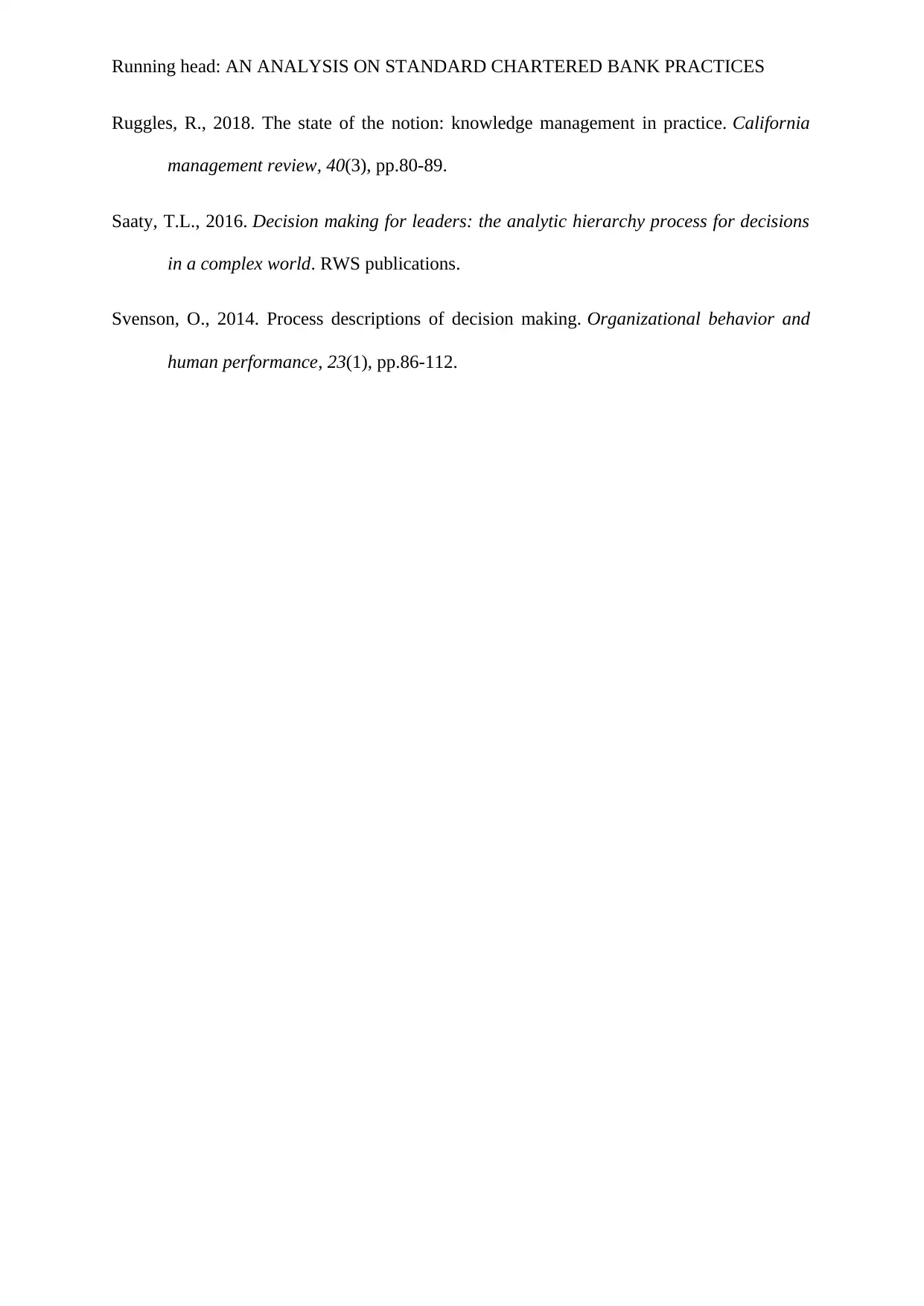
Running head: AN ANALYSIS ON STANDARD CHARTERED BANK PRACTICES
Ruggles, R., 2018. The state of the notion: knowledge management in practice. California
management review, 40(3), pp.80-89.
Saaty, T.L., 2016. Decision making for leaders: the analytic hierarchy process for decisions
in a complex world. RWS publications.
Svenson, O., 2014. Process descriptions of decision making. Organizational behavior and
human performance, 23(1), pp.86-112.
Ruggles, R., 2018. The state of the notion: knowledge management in practice. California
management review, 40(3), pp.80-89.
Saaty, T.L., 2016. Decision making for leaders: the analytic hierarchy process for decisions
in a complex world. RWS publications.
Svenson, O., 2014. Process descriptions of decision making. Organizational behavior and
human performance, 23(1), pp.86-112.
⊘ This is a preview!⊘
Do you want full access?
Subscribe today to unlock all pages.

Trusted by 1+ million students worldwide
1 out of 12
Related Documents
Your All-in-One AI-Powered Toolkit for Academic Success.
+13062052269
info@desklib.com
Available 24*7 on WhatsApp / Email
![[object Object]](/_next/static/media/star-bottom.7253800d.svg)
Unlock your academic potential
Copyright © 2020–2025 A2Z Services. All Rights Reserved. Developed and managed by ZUCOL.





